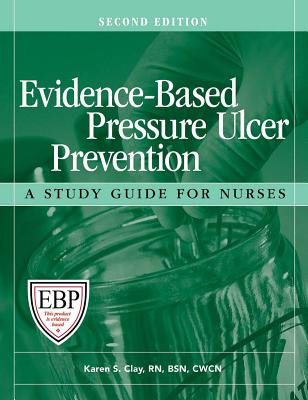

 Hcpro Inc.
Hcpro Inc.
Evidence-Based Pressure Ulcer Prevention, Second Edition: A Study Guide for Nurses


Key Metrics
- Jessica Baggia
- Hcpro Inc.
- Paperback
- 9781601461711
- 10.7 X 8.4 X 0.4 inches
- 1 pounds
- Medical > Dermatology
- English
 Secure Transaction
Secure TransactionBook Description
Effective October 2008, Medicare will no longer compensate hospitals for the treatment of reasonably preventable pressure ulcers acquired during patient stays, or if the hospital does not thoroughly and accurately document that a pressure ulcer was present on admission.Don't be caught off guard
In this new edition of our best-selling book, Evidence-Based Pressure Ulcer Prevention: A Study Guide for Nurses, Second Edition, discover the risk-factor assessment and prevention strategies you need to implement a successful pressure ulcer prevention program. Completely updated to include the latest staging requirements as defined by the National Pressure Ulcer Advisory Panel, it also includes valuable information on staging pressure ulcers in all skin types, including darker skin, and the most up-to-date treatment guidelines.
With Evidence-Based Pressure Ulcer Prevention you can create your own staff training system or give to nurses for self-study. The book is designed to help nursing staff understand the vital role they play in pressure ulcer prevention, and contains evidence-based methods to prevent, assess, and treat pressure ulcers in acute care. It's filled with clinical instruction and documentation tips to reduce legal liability when pressure ulcers do occur.With this useful guide your staff will:
- Fulfill Joint Commission training requirements
- Comply with ANCC Magnet Recognition Program(R) requirements for data collection
- Learn how to prevent pressure ulcers in light of CMS' new stance
- Provide evidence-based nursing care
- Train when it is most convenient for them
- Align with Institute for Healthcare Improvement goals
Now with a CD-ROM!
The helpful CD-ROM is packed with forms and tools you can either use in training or nurses can use everyday in their patient assessments. The CD-ROM also includes images of various stages of pressure ulcers that can be used for staff training.This guide will show you how to:
- Develop a pressure ulcer risk assessment and prevention program
- Encourage and ensure effective reporting of pressure ulcers
- Plan care through proactive screening and interdisciplinary assessment
- Implement organizationwide steps that will help reduce your patients' risk of pressure ulcers
- Define pressure ulcer.
- Explain the role of impaired blood supply in the creation of pressure ulcers.
- Identify two influences that put patients at risk pressure ulcers that may be beyond the caregivers' control.
- Define the rule of 30.
- Explain where on the body pressure is prevented by using the rule of 30.
- Identify two reasons why heels are the second most common sites of pressure ulcers.
- Provide an example of how to off-load pressure from heels.
- Explain the four pressure ulcer and two deep tissue stages.
- Define backstaging.
- Explain why backstaging is not recommended by the National Pressure Ulcer Advisory Panel.
- Identify the two most widely used risk-assessment tools.
- List four intrinsic factors for pressure ulcer development.
- Identify the four types of tissue to be observed in a pressure ulcer.
- Identify the three-dimensional measurement formula.
- State three possible strategies nurses can perform to relieve pain during dressing changes.
- Identify the three microbiologic states within pressure ulcers.
- Explain why taking creative liberties with physician-ordered treatments is a bad practice.
- Identify two care-plan risk factors.
- Explain why proper, detailed documentation is important.
- Define MVTR.
- Identify good and bad MVTR.
- List the seven rights to consider when performing dressing changes.
- List two wound-care products that promote a moist wound environment.
- Define negative pressure wound therapy.
- List two factors to consider about the patient before administering negative pressure wound therapy.
- Identify the three parameters the PUSH tool is designed to monitor.
- List the three factors that must be consistently addressed prior to identifying a wound as recalcitrant.
- List three aspects of risk and care about which primary caregivers, patients, families, and other professional staff should be educated.
Take a look at the table of contents:
Chapter 1: Background and scope
Chapter 2: Prevention
Chapter 3: Development and staging of pressure ulcers
Chapter 4. Risk assessment
Chapter 5: Wound assessment
Chapter 6: Pain, nutrition, and infection assessment
Chapter 7: Common documentation and treatment problems
Chapter 8: Treatment concepts
Chapter 9: Wound-care products
Chapter 10: Wound healing
Chapter 11: Building your team, program, and tools
Who needs this book?
Nurses, CNOs/VPs of patient services, risk managers, directors of nursing, patient safety directors, staff development coordinators, quality directors, HR
Not enough time to organize a group learning session?
This tool is great for self-learning, too! The self-study format allows nurses to use this guide when it is most convenient for them. The exam helps assess and document the effectiveness of training and the knowledge gained by the learner.Faculty Disclosure Statement: HCPro Inc. has confirmed that none of the faculty/presenters or contributors have any relevant financial relationships to disclose related to the content of this educational activity.
Videos
No Videos
Community reviews
Write a ReviewNo Community reviews